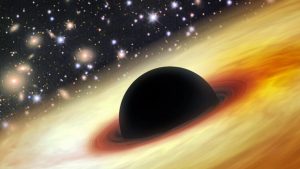The largest black holes found so far in the nearby universe have masses more than 10 billion times that of the sun.
largest black holes found so far in the nearby universe have masses more than 10 billion times that of the sun. In comparison, the black hole at the center of the Milky Way is thought to have a mass only 4 million to 5 million times that of the sun.
Although not even light can escape the powerful gravitational pulls of black holes — hence, their name — black holes are often bright. That’s because they’re surrounded by features known as accretion disks, which are made up of gas and dust that heat up and give off light as it swirl into the black holes. Astronomers suspect that
quasars, the brightest objects in the universe, contain super massive black holes that release extraordinarily large amounts of light as they rip apart stars.
So far, astronomers have discovered 40 quasars — each with a black hole about 1 billion times the mass of the sun — dating back to when the universe was less than 1 billion years old. Now, scientists report the discovery of a super massive black hole 12 billion times the mass of the sun about 12.8 billion light-years from Earth that dates back to when the universe was only about 875 million years old.
This black hole — technically known as SDSS J010013.02+280225.8, or J0100+2802 for short — is not only the most massive quasar ever seen in the early universe but also the most luminous. It is about 429 trillion times brighter than the sun and seven times brighter than
the most distant quasar known.
The light from very distant quasars can take billions of years to reach Earth. As such, astronomers can see quasars as they were when the universe was young.
This black hole dates back to a little more than 6% of the universe’s current age of 13.8 billion years.
“This is quite surprising because it presents serious challenges to theories of black hole growth in the early universe,” said lead study author Xue-Bing Wu, an astrophysicist at Peking University in Beijing.
Accretion discs limit the speed of modern black holes’ growth. First, as gas and dust in the disks get close to black holes, traffic jams slow down any other material that’s falling into them. Second, as matter collides in these traffic jams, it heats up, emitting radiation that drives gas and dust away from the black holes.
